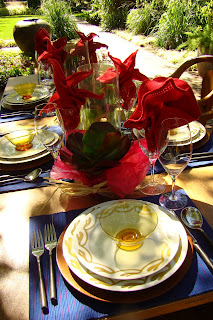(Red Poppies in Jim's Garden, photo by Jan Johnsen)
Bold. Bright. Pop.
This is what RED adds to a garden.
RED, an eye catching hue, stands up to the summer sun's withering glare in the afternoon.
When all pastels fade away, red, orange and yellow sing their hearts out....and RED always steals the show.
 RED has a vivid history - Check it out on the sensational color website. It is the color of the root chakra (this means 'energy point) of the body:
RED has a vivid history - Check it out on the sensational color website. It is the color of the root chakra (this means 'energy point) of the body:"This chakra is located at the base of the spine and allows us to be grounded and connect to the universal energies. Groundedness, belonging...."
(sounds perfect for all us grounded gardeners)
In Japan RED is associated with certain deities. Their “Shinkyo” (Sacred Bridge) in Nikko, Japan is a wonderful example of the contrast RED makes with green in a natural setting.
You can also see how effective RED is in the modern Chinese Red Ribbon in Tanghe River Park, designed by Turenscape :
This use of RED has always been popular in Chinese gardens...Here is another example showing a red Tori or gate...what great proportions too.
I was first introduced to the power of red by the French artist, Matisse...I loved his 'Red Studio' when I first saw it as a child in a NY museum:
And of course Red furniture outdoors attracts the eye:
Here is a landscape I designed - the red bench definitely dominates the scene:

I often plant RED Callibrachoa in my clients' gardens. It is a eye catcher for sure!
I also plant a mass of red begonias next to dark green leucothoe to make a statement. This is what I did along an entry walk:
Of course the spilling over of Superbena Royale Red Verbena in a pot is unmatched:
(courtesy of Proven Winners)
And Nemesia, a cool season annual flower, is also a knock out in red, Sunsatia Cranberry Nemesia :
(courtesy of Proven Winners)
Did you know that Bees can’t see the color red, but they can see all other bright colors. Red flowers are usually pollinated by birds, butterflies, bats, and wind, rather than bees.
I love red tulips against a white fence so I planted these Parade tulips:

(Jan Johnsen)
And of course the traditional Red Geranium always signifies 'welcome' in so many languages:

So please consider 'spicing up' your outdoor surroundings with some RED today - you won't regret it!

(Silas Mountsier Garden, photo by Jan Johnsen)













































